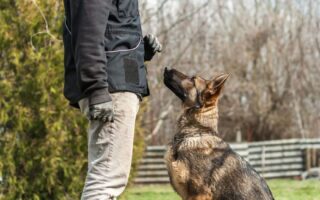In the ever-evolving world of canine companionship, the path to a well-behaved dog can often seem like a winding road filled with conflicting philosophies and methods. Amidst the swirl of opinions, one approach has emerged as a beacon of balanced understanding: balanced dog training. This method harmonizes traditional rewards and contemporary techniques, promoting not just obedience but a deeper connection between dog and owner. As we embark on this exploration of balanced dog training, we aim to illuminate its principles, benefits, and practical applications, offering insights that can transform your relationship with your furry friend. Whether you’re a seasoned trainer or a new dog owner, join us as we uncover the symphony of training that respects both the instincts of dogs and the expectations of their human partners.
Table of Contents
- Understanding the Principles of Balanced Dog Training
- Incorporating Positive Reinforcement for Optimal Results
- Navigating Corrections and Consequences Intelligently
- Creating a Customized Training Plan for Your Dog’s Needs
- Q&A
- Concluding Remarks
Understanding the Principles of Balanced Dog Training
Balanced dog training is rooted in the understanding that effective communication with your dog extends beyond simple commands. It embraces a holistic approach that fosters a healthy relationship based on trust, respect, and consistency. The key principles include:
- Positive Reinforcement: Rewarding desirable behavior encourages your dog to repeat it.
- Natural Consequences: Allowing your dog to experience the outcomes of their actions fosters understanding.
- Clear Boundaries: Establishing rules helps your dog know what is expected of them.
- Emotional Balance: Recognizing and addressing your dog’s emotional needs supports their overall wellbeing.
To create a well-rounded training program, it is essential to assess and adapt your methods to the individual dog’s temperament and learning style. Consider incorporating various training techniques, such as:
| Training Technique | Description |
|---|---|
| Clicker Training | Uses a click sound to mark and reward desired behaviors immediately. |
| Leash Training | Focuses on walking politely on a leash, reducing pulling and distractions. |
| Desensitization | A gradual exposure to fearful stimuli helps build confidence. |
| Socialization | Encourages interaction with other dogs and people to improve behavior. |
Incorporating Positive Reinforcement for Optimal Results
To achieve a well-rounded approach in dog training, integrating positive reinforcement techniques not only fosters a strong bond between the dog and the handler but also enhances the learning process. By rewarding desired behaviors, you encourage your dog to repeat those actions, making training more enjoyable and effective. Consider the following methods to implement this strategy:
- Treats: Use small, tasty morsels that your dog loves to motivate them.
- Verbal Praise: Combine treats with enthusiastic verbal affirmations to reinforce good behavior.
- Toys: For play-oriented dogs, toys can serve as an effective reward.
Moreover, understanding the timing of your reinforcement is crucial. Immediate rewards help your dog make connections between their actions and the resulting praise or treats. For structured tracking of progress, a simple table can help visualize reinforcement methods and their effectiveness:
| Behavior | Method of Reinforcement | Effectiveness Rating |
|---|---|---|
| Sit | Verbal Praise & Treat | ⭐⭐⭐⭐⭐ |
| Stay | Toy Reward | ⭐⭐⭐⭐ |
| Come | Treat & Affection | ⭐⭐⭐⭐⭐ |
Maintaining consistency in your reinforcement approach is key to achieving optimal results. When your dog recognizes and anticipates rewards for their good behavior, they are more likely to engage positively during training sessions. This not only benefits your dog but also enriches the overall training experience for both of you.
Navigating Corrections and Consequences Intelligently
Effective dog training requires a thoughtful approach to corrections and consequences. To maintain a balanced relationship with your canine companion, it’s essential to understand that not all corrections are created equal. When implementing corrections, consider the following key principles:
- Timing: Corrections should occur immediately after the undesired behavior to enhance understanding.
- Proportionality: The severity of the correction should match the behavior; avoid excessive punishment.
- Positive Reinforcement: Reinforce good behavior with rewards to create a balanced training strategy.
Moreover, the consequences that follow a dog’s actions can significantly shape their behavior over time. Striking the right balance between correction and encouragement cultivates a learning environment where your dog can thrive. Here’s a simple overview of effective consequence types:
| Type of Consequence | Description |
|---|---|
| Redirecting | Guide the dog towards desired behaviors instead of just punishing undesired ones. |
| Time-Outs | Provide a brief break from interaction to help the dog reflect on its actions. |
| Natural Consequences | Allow the dog to experience the outcome of its behavior in a safe context. |
Creating a Customized Training Plan for Your Dog’s Needs
Every dog has its unique personality, preferences, and learning style, which is why crafting a tailored training plan is essential for effective results. Begin by assessing your dog’s current skills and behavior. Consider the following factors when creating your plan:
- Age: Puppies may require different training methods than older dogs.
- Breed: Some breeds have natural tendencies that can influence training strategies.
- Temperament: Assess whether your dog is shy, bold, anxious, or relaxed to adapt the approach accordingly.
Once you’ve gathered this information, set specific and achievable goals. Here are a few examples to inspire your plan:
| Goal Type | Description | Time Frame |
|---|---|---|
| Basic Commands | Teach fundamental cues like sit, stay, and come. | 2-4 weeks |
| Socialization | Introduce your dog to new environments and other pets. | Ongoing |
| Leash Manners | Train your dog to walk calmly on a leash without pulling. | 3-6 weeks |
This customized training plan will not only enhance your dog’s skills but also strengthen the bond between you and your furry companion. Remember to remain patient and consistent, celebrating small victories along the way to ensure a rewarding training journey.
Q&A
Q&A on Balanced Dog Training
Q1: What is balanced dog training?
A1: Balanced dog training is an approach that combines various techniques and methods to teach dogs effectively while considering their individual needs and personalities. It typically integrates positive reinforcement tactics—like treats and praise—with disciplinary strategies, such as corrections, to create a well-rounded training experience. This method emphasizes harmony between behavioral guidance and the creation of a positive relationship between dog and owner.
Q2: Why is it called “balanced”?
A2: The term “balanced” reflects the duality of the approach. It recognizes that dogs, much like humans, thrive on structure and boundaries while also needing love and encouragement. By balancing positive and negative reinforcements, trainers can address unwanted behaviors while promoting desirable actions, creating a comprehensive learning environment.
Q3: Can you give examples of positive reinforcement and disciplinary techniques used in balanced training?
A3: Certainly! Positive reinforcement might involve offering a treat when your dog sits on command or praising it when it returns to you off-leash. On the flip side, disciplinary techniques could include using a leash correction to redirect a dog that is pulling on its walk or employing a firm “no” when a dog engages in undesirable behavior, such as jumping on guests. The key is to use these techniques judiciously and compassionately.
Q4: Is balanced dog training suitable for all breeds?
A4: Yes, balanced dog training can be adapted to suit the needs of any breed, as long as the trainer understands the dog’s specific temperament and behavior traits. Some breeds may respond better to positive reinforcement, while others may need a firmer hand initially. The goal is to understand and cater to the individual dog’s personality to foster effective training.
Q5: What are some potential drawbacks of this method?
A5: One concern with balanced training is that if not implemented correctly, disciplinary techniques may lead to fear or anxiety in some dogs. It’s crucial for trainers to focus on timing and communication when applying corrections. Misuse can create confusion and stress, which may hinder the training process. Additionally, some dog owners may feel more inclined to lean heavily on corrections rather than establishing a positive rapport with their pets.
Q6: How can owners get started with balanced dog training at home?
A6: Owners can start by establishing clear expectations for their dog and incorporating consistent training sessions. Begin with positive reinforcement for good behavior, like rewarding them when they follow commands. Gradually introduce corrective measures when unwanted behaviors occur, always ensuring that the corrections are proportional and fair. Consider seeking guidance from a professional balanced trainer to offer additional insights and support.
Q7: What do proponents of balanced training say about its effectiveness?
A7: Advocates of balanced dog training often emphasize its flexibility and adaptability, arguing that it can produce well-behaved dogs without compromising the owner-dog bond. They believe that by using an array of techniques, owners can address a variety of behavioral issues more effectively, leading to a happy, obedient dog who understands boundaries while being encouraged to thrive in a positive environment.
Q8: How does balanced training compare with other training methods?
A8: Compared to purely positive reinforcement methods, balanced training recognizes the utility of corrections in situations where obedience or safety is paramount. While some methods focus exclusively on positive approaches, balanced training aims to create a more versatile toolkit for trainers. However, the effectiveness of any training method ultimately relies on the trainer’s understanding of their dog and commitment to creating a mutually respectful relationship.
—
Q9: What is the ultimate goal of balanced dog training?
A9: The ultimate goal of balanced dog training is to foster a well-adjusted and behaviorally stable dog that understands both the joys of companionship and the rules of engagement. By blending various techniques, trainers aim to create a respectful partnership where dogs feel secure and their owners have the tools to communicate effectively, leading to a harmonious coexistence.
Concluding Remarks
As we conclude our exploration of balanced dog training, it’s essential to remember that this approach is not merely a set of techniques; rather, it embodies a philosophy that considers the unique needs of both dog and handler. Like a harmonious dance, balanced training seeks to align motivation, understanding, and discipline, creating a partnership rooted in mutual respect and trust.
As you embark on your own journey with your canine companion, reflect on the principles we’ve discussed and how they can be adapted to fit your lives together. Every dog is an individual, and the path to a fulfilling relationship is one of patience and adaptability. Whether it’s through positive reinforcement, structured boundaries, or a blend of techniques, the ultimate goal remains the same: cultivating a bond where learning thrives and both you and your dog can flourish.
So, as you take your next step forward, carry with you the wisdom that balance is key—not just in training, but in nurturing the profound connection that makes the human-dog relationship truly special. Happy training!


